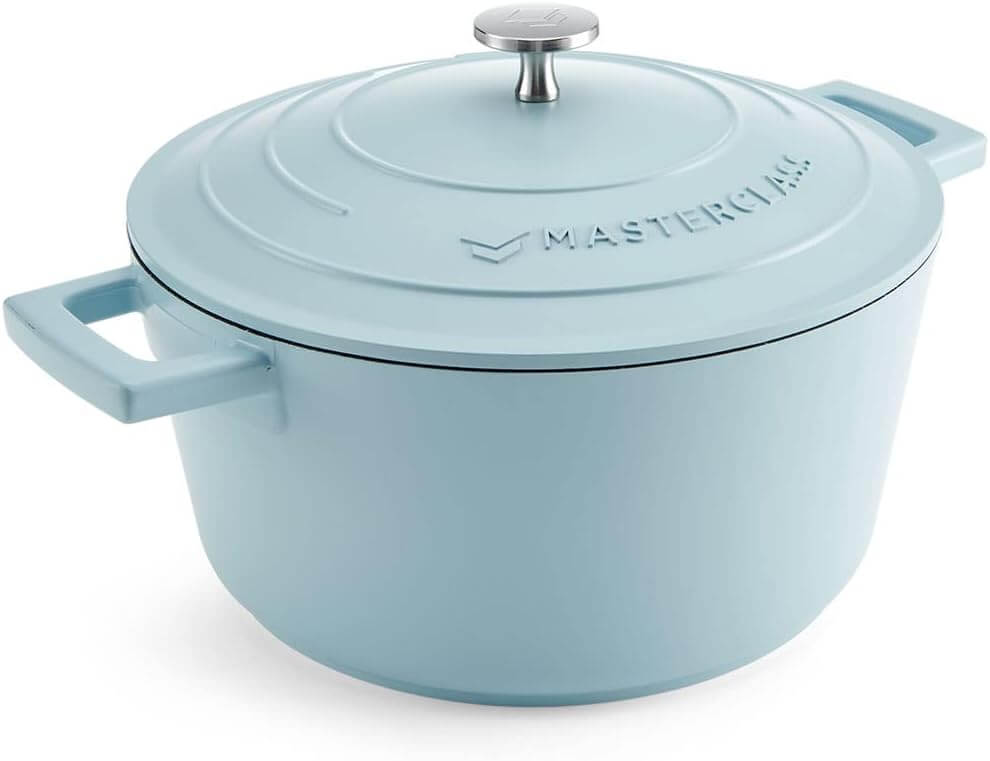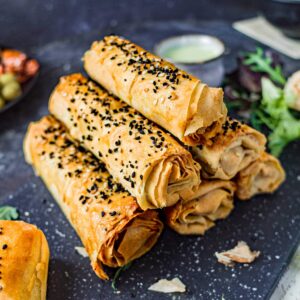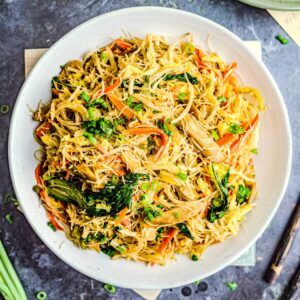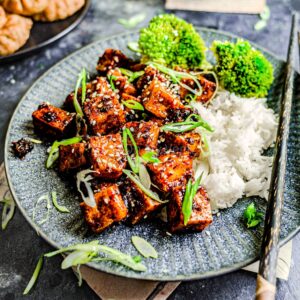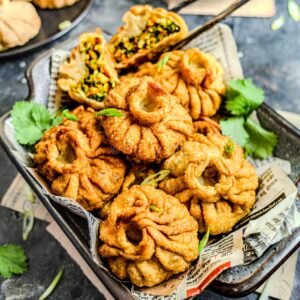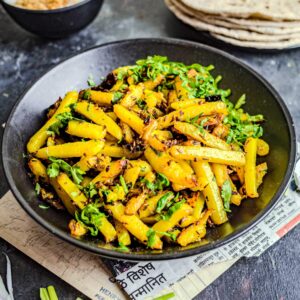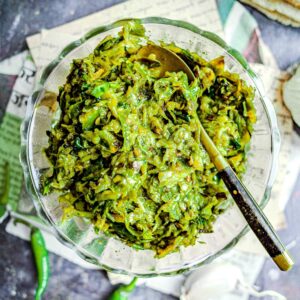Vegan Tantanmen Ramen (Tan Tan Ramen)
Vegan tantanmen ramen has a rich, silky, fiery, broth with a toasted, nutty aroma, perfectly chewy ramen noodles, vibrant pak choy, meaty, juicy, and oh-so unctuous mince, plus garlicky chilli oil. It’s comfort in a bowl.
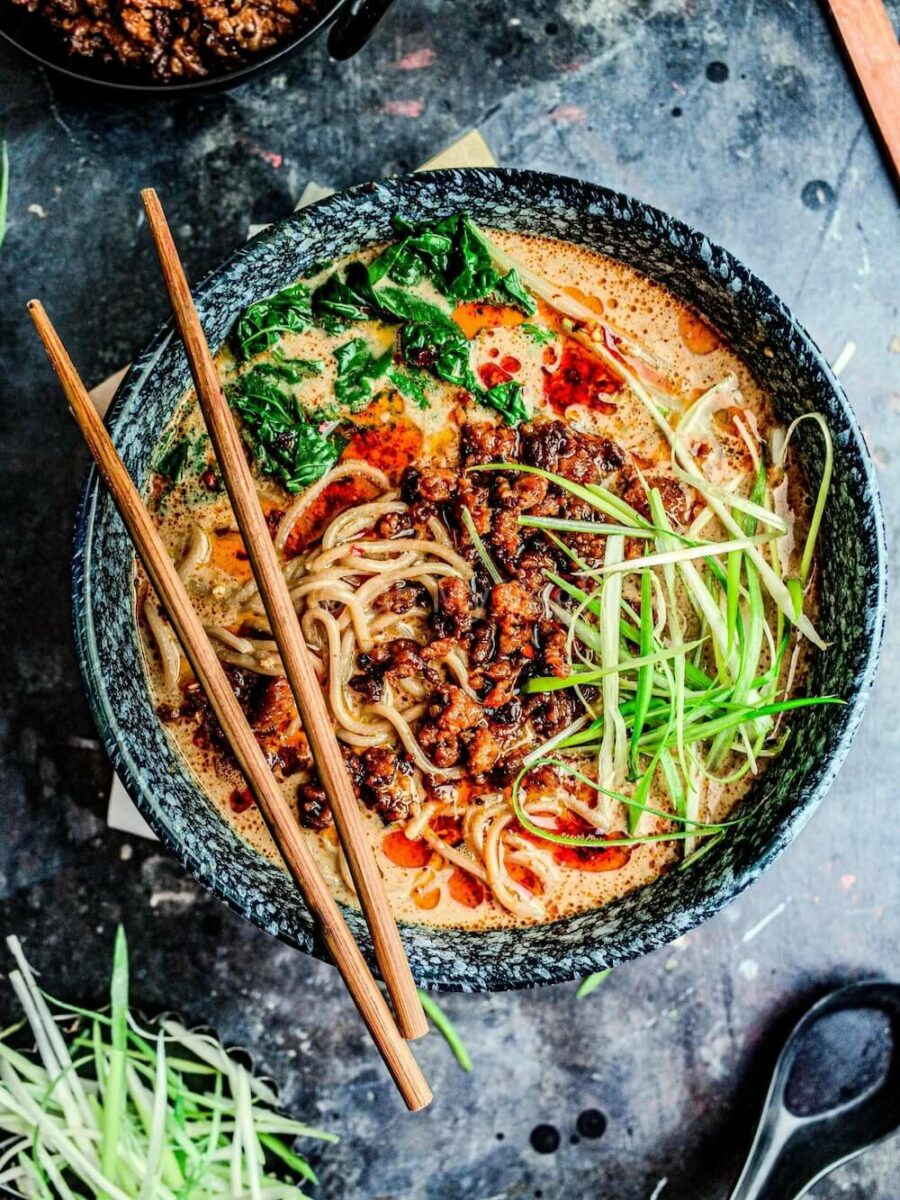
Excluding my garlic chilli oil and zucchini instant noodles, this vegan tantanmen ramen is the first Japanese noodle dish shared on Oh My Veg. Can you believe it? It’s been more than three years of blogging, and this is my first ramen recipe! Oh well, that’s all about to change!
I recently reviewed tan tan ramen at House of Fu Manchester and found the dish far too spicy … However, always the optimist, there was a silver lining: this was the perfect opportunity to make it at home! So, I worked on this recipe for weeks, slowly perfecting the nutty flavours, the umami taste, the creaminess, and the spice level.
As soon as I tasted the first spoonful of the ramen broth, I realized my recipe testing had come to an end. This was the one!
Amazingly, the whole recipe comes together in less than 30 minutes. And I can attest it’s miles better than you’re likely to find in a restaurant, just like my other fakeaway plates!
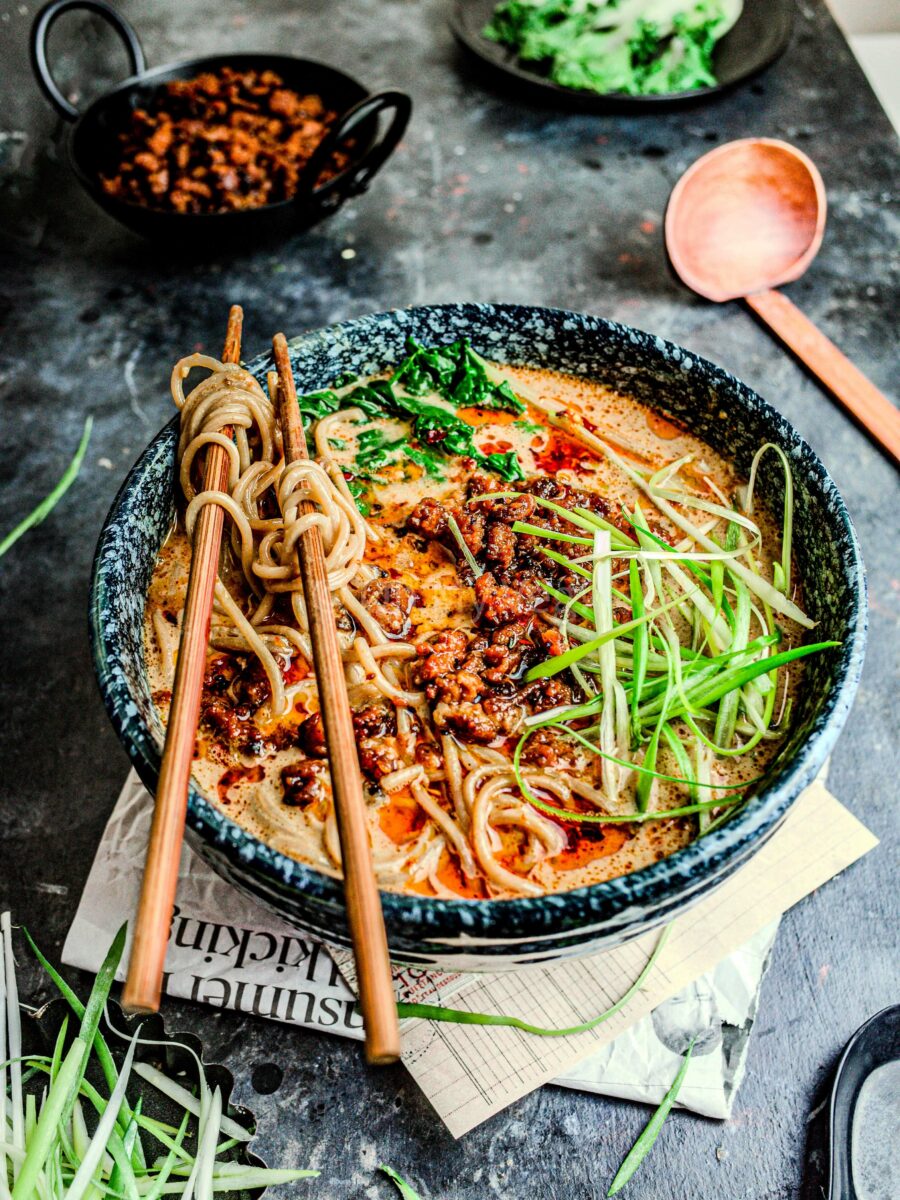
What is Tantanmen Ramen?
Tantanmen is a variety of ramen vastly different from the classic shoyu, miso, shio, or tonkotsu you’ll usually spy on Japanese restaurant menus.
The broth focuses heavily on heady, fiery spice from chilis, thanks to a combination of chilli sauce and chilli oil enriched with the distinctive numbing flavour of Sichuan peppercorns. What makes it really unique, though, is the layers of deep and rich flavour from nutty toasted sesame paste. Complex creaminess from soy milk finishes off the ramen broth.
The spicy, nutty, umami-packed broth complements the fatty pork mince and fresh, crunchy pak choy leaves. I also like to top my tan tan ramen with a generous pile of spring onions (green onions or scallions) for freshness.
Since we’re making vegan tantamen ramen, I use a plant-based mince for this recipe!
Tantanmen Ramen History / Tantanmen Ramen Origin
Much like other Japanese foods (such as vegetable gyoza, a personal favourite!), tantanmen (tan tan ramen) has roots in China. Specifically, the dish hails from Chengdu, in the Sichuan province, where people started cooking the dish in the 1800s.
Of course, as often happens, the dish evolved. The original root of tantanmen is known as dan dan noodles (spelt “tan tan” when transliterated from Japanese). Featuring noodles tossed with numbing Sichuan peppercorns, spicy chilli oil, pork mince, and pickled mustard greens, you can no doubt already see the similarities with tantanmen. Dan dan noodles still boast widespread popularity in our modern times!
The dish translates to “noodles being carried,” as “dan dan” refers to the large pole vendors would carry on their shoulders, with a pot of noodles hanging from either end.
The dish spread from Sichuan province to Shangai, developing a more soupy base and less chilli. From there, it travelled to Japan, where the dish we now know as tantanmen emerged. The Japanese focused on a rich sesame base, substituted ramen noodles, and added a lot more broth to make a rich ramen.
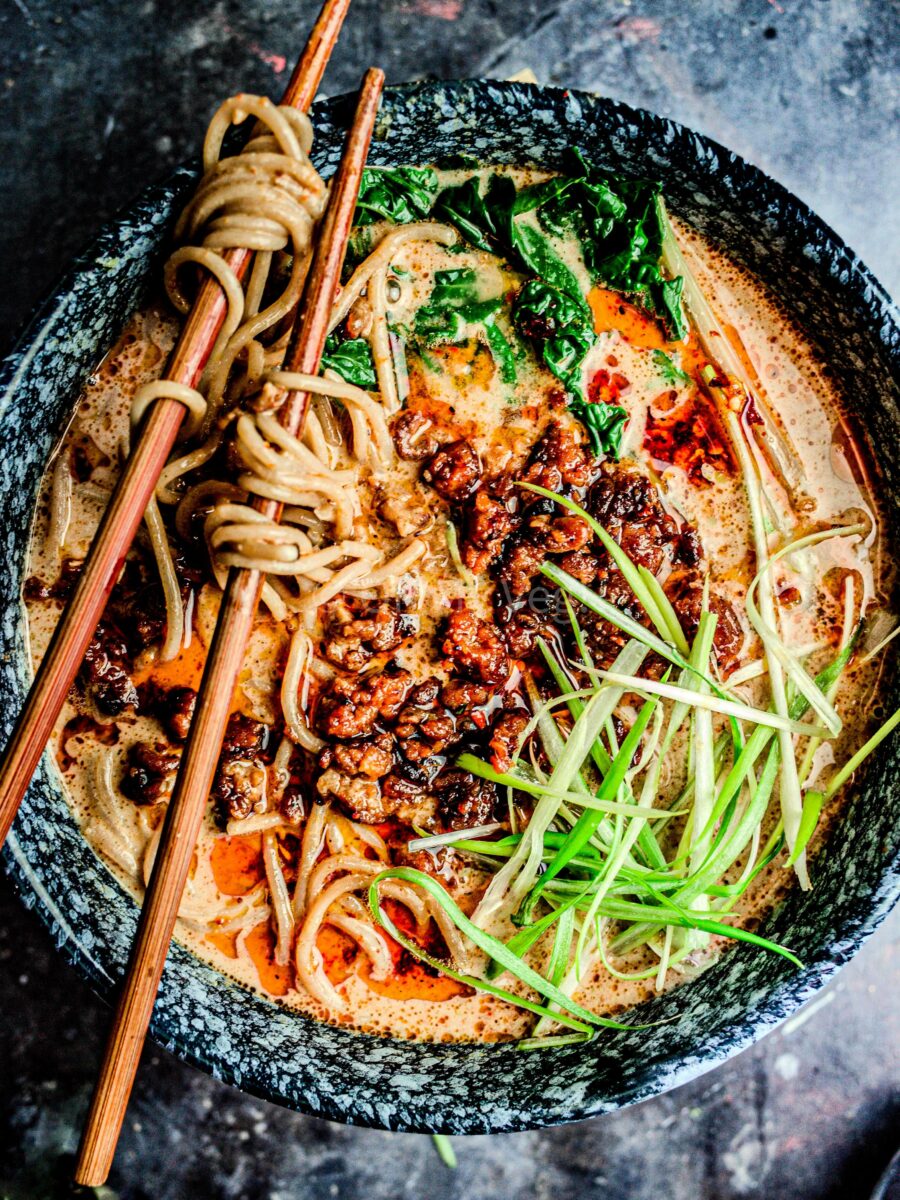
What is Tantanmen Ramen Made Of
This tantanmen ramen comprises three essential elements: the tare (seasoning), the broth, and the toppings.
The tare is rich, loaded with umami, and intensely nutty. The broth is creamy, adding layers of additional flavour, while the toppings bring the whole dish together. And, of course, we can’t forget the ramen noodles themselves!
Below, find a complete list of all the ingredients you’ll need for this vegan tantanmen. Use it as a reference for a shopping list! While quantities aren’t listed here, the recipe card below has complete details.
What is in Vegan Tantanmen Ramen?
- Vegan mince replaces the pork mince in traditional tantanmen ramen. Use your favourite brand; I’ve used numerous grocery store brands with excellent results. I like OmniPork!
- Neutral oil is a flavour carrier, meaning it helps to bring out the nuanced and subtle flavours of our other ingredients.
- Ginger is spicy and peppery, adding to the complexity of our chilli oil.
- Garlic contributes an almost buttery flavour to the tantanmen ramen.
- Japanese chilli oil brings the fiery spiciness tantanmen is known for. Called “la-yu,” it is infused with sesame oil, garlic, ginger, Sichuan peppercorns, chilli flakes, and Negi onions (although spring onions are a great substitute.) More on that later!
- Chinese chilli bean paste, specifically doubanjiang, is vital. Doubanjiang is a Chinese chilli paste made with fermented soybeans and chilis. It’s typically called “spicy bean paste,” an indispensable flavour in this vegan tantanmen ramen.
- Sesame seed paste provides a rich depth of flavour and intensely nutty notes to the ramen broth. Use neri goma, a Japanese variety of roasted sesame paste.
- Rice vinegar cuts through the creaminess with a slight hint of acidity. It’s a very mild vinegar.
- Dark soy sauce adds umami to this spicy ramen dish.
- Soy milk provides the creaminess of the broth and its characteristic base flavour. Always use unsweetened soy milk when making ramen. I use the unrefrigerated brands from my local grocery store.
- Vegetable stock gives another layer of flavour to the vegan ramen broth. You can use water, although I recommend a low-sodium stock.
- Ramen noodles are, of course, a must for ramen! Use fresh or dried noodles. If you’re gluten-free, you can swap the traditional ramen for 100% buckwheat ramen noodles.
- Pak Choy is a refreshing crunch, crisp, and bright flavour.
- Spring onions are a great garnish with a sharp flavour profile.
Ingredient Substitutions
Unless you’re a Japanese food aficionado, the chances are you won’t have all the ingredients you need in your pantry.
I always recommend exploring your local Asian grocery store. It’s one of my favourite things to do … I even dream about it! (What’s wrong with me?)
However, some of you don’t have a local Asian store within driving distance. In this case, my Amazon shopfront is an excellent resource for finding ingredients you may not have access to in your hometown. I always recommend using traditional, authentic ingredients when possible.
If all else fails, then it’s time to get substituting. Luckily, many of the more “rare” ingredients in tantanmen can be made at home or replaced. Let’s take a look at how!
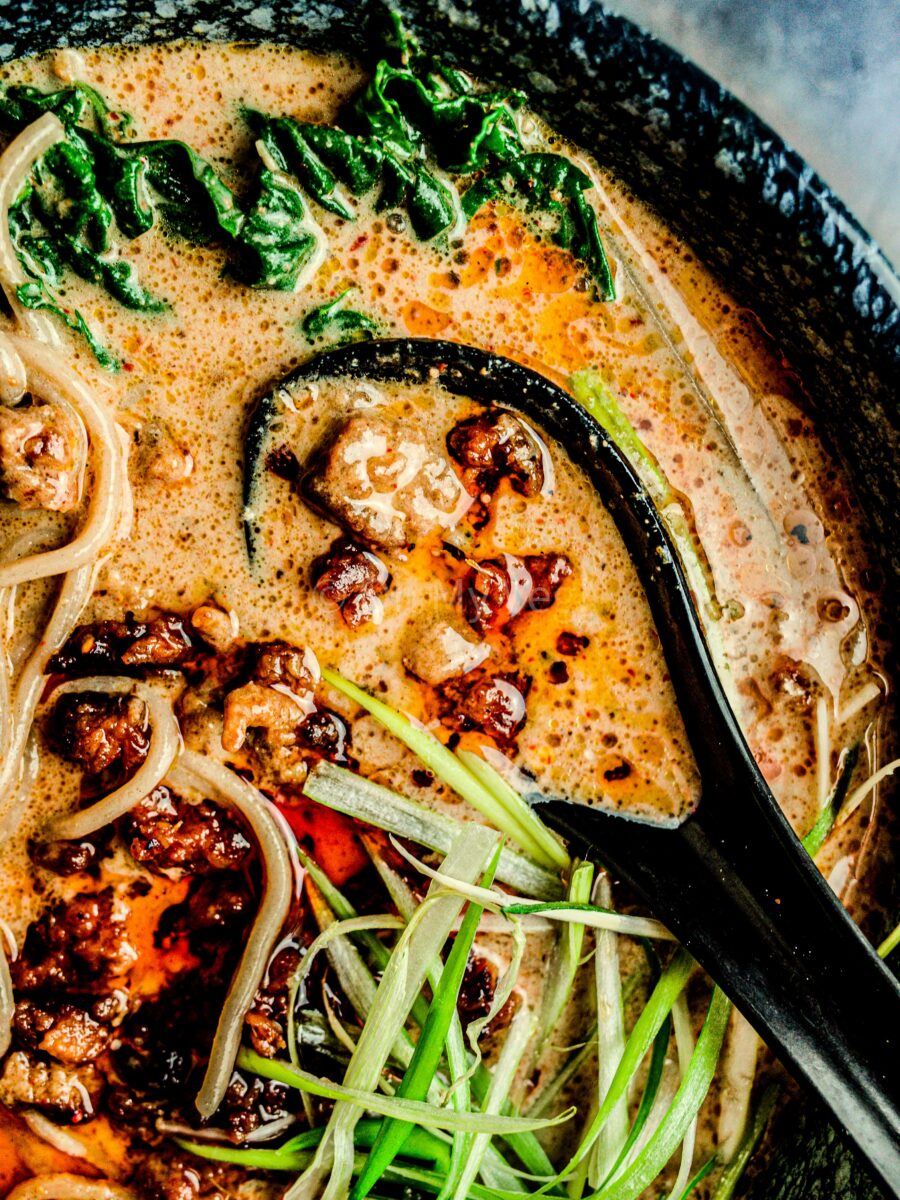
How to Make Tantanmen Ramen
Making vegan tantanmen ramen is surprisingly easy. While it’s not as quick as instant noodles, the taste is incomparable, and you’ll still only need to set aside around 30 minutes for the prep and cooking. That’s nothing!
To cut down on the cooking time, I always suggest familiarising yourself with the recipe beforehand. Read this summary a few times, then scroll down to the recipe card below for more in-depth instructions.
- Fry off the vegan mince with seasonings: chopped ginger, garlic, spicy Chinese bean paste, light and dark soy sauce, and sesame seed paste. Take half out of the pan.
- Mix the tare by combining sesame seed paste, miso paste, chili oil, vinegar, and soy sauce. Add it to the pan and fry.
- Make the broth by adding vegetable stock, soy milk, and seasoning (sea salt).
- Prepare the garnishes by blanching the pak choy and finely shredding the spring onions.
- Cook the ramen according to package instructions.
- Assemble the vegan tantanmen ramen by adding the noodles to a large ramen bowl, then the broth, leftover mince, and garnishes.
Cookware You Need
RAMEN BOWLS
Cooking Pot
Noodle Basket
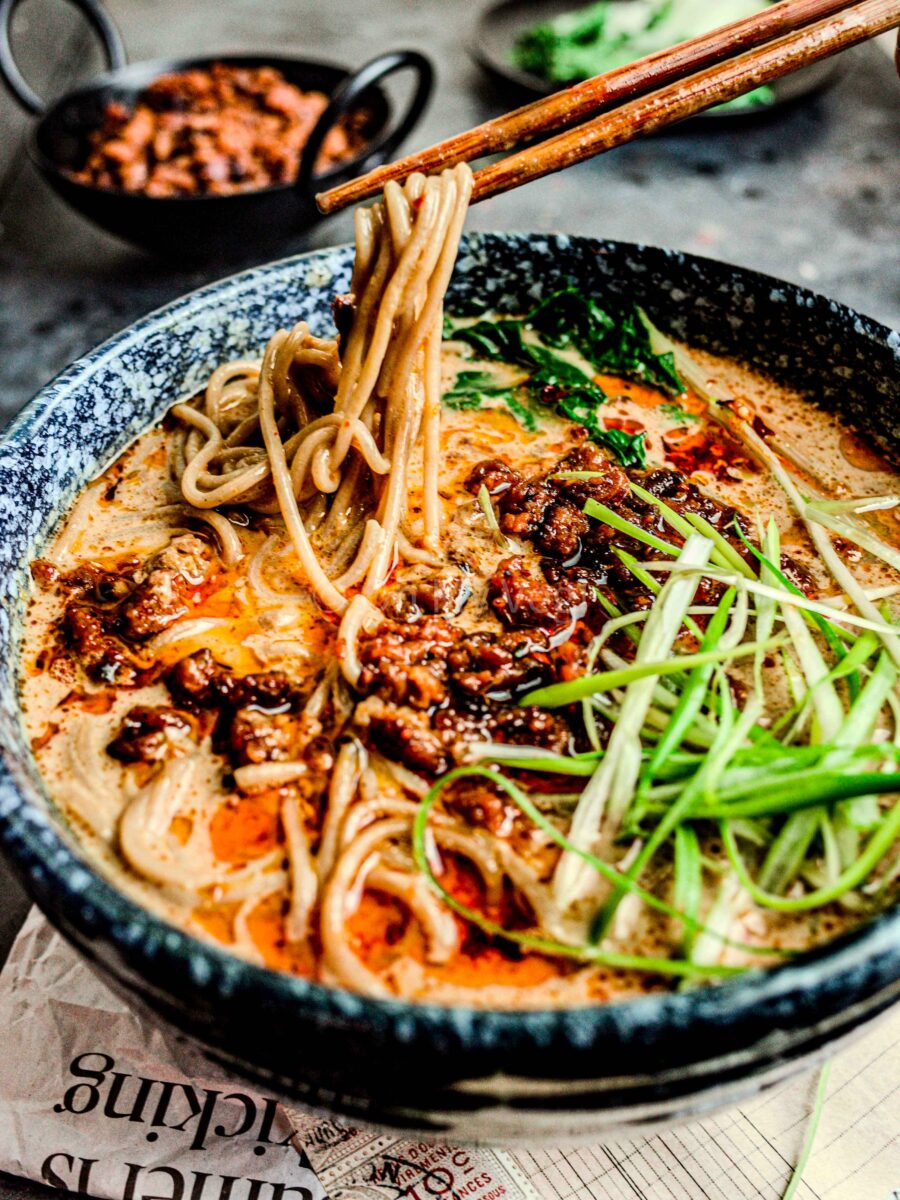
Tips to Make the BEST Vegan Tantanmen Ramen
Perhaps you’re making ramen for the first time and worried about how it will turn out. I’m here to put your fears to rest. This ramen recipe is foolproof! But, to make the road to success even easier, here are some critical tips for victory:
- Use plenty of oil — it’s in the recipe for a reason! The vegan mince doesn’t contain natural fats like animal meat, so we need to add it ourselves to carry all that juicy flavour.
- Sear the vegan mince slightly for extra flavour. It’s crucial here because we need to pack as much flavour into the plant-based meat as possible.
- Undercook the noodles so they retain a bite even after sitting in the hot ramen broth. Nobody likes soggy noodles!
- Don’t skimp on the toppings — even if you don’t like greens! Trust me, the fresh, bright flavour and crispness of texture elevates the tantanmen ramen and prevents it from becoming too “samey.”
- Avoid overcooking the broth after adding the vegetable stock and soy milk. It can cause the soy milk to separate, causing all sorts of issues with the tantanmen! We want it at a slight simmer while we finish cooking our toppings.
- Adjust the spiciness to taste by adding more Japanese chilli oil to top the ramen. This way, it’s possible to cater to many different spice tolerances.
This Recipe Is …
Vegan Tantanmen Ramen
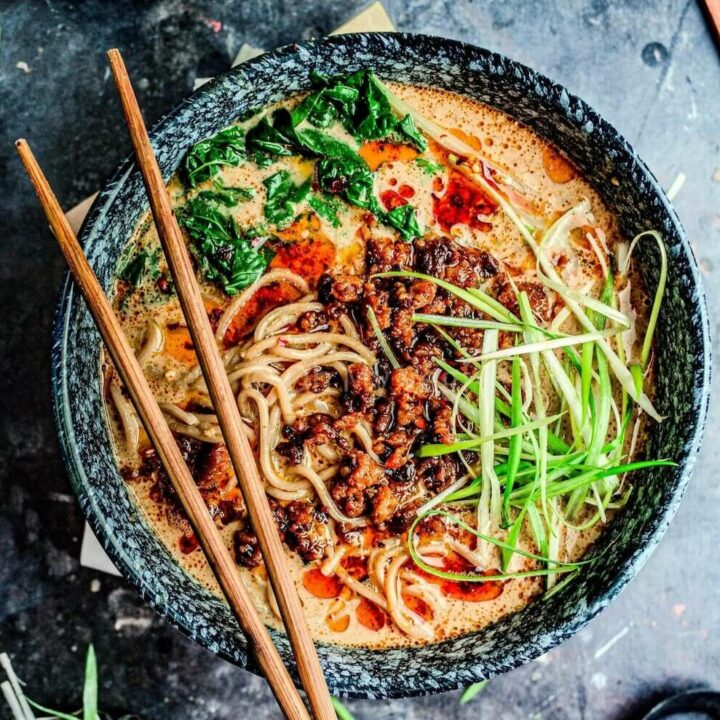
Noodles in a creamy, nutty, spicy, and umami-packed broth, plus succulent vegan mince? This vegan tantanmen ramen couldn't be any tastier.
Ingredients
For the Ground Mince
- 3 tbsp Oil
- 300g Vegan Mince
- 1.5 tsp Ginger, finely minced
- 1 tbsp Garlic, finely minced
- 2.5 tbsp Doubanjiang (spicy bean paste)
- 2 tsp Light Soy Sauce
- 2 tsp Dark Soy Sauce
- 4 tbsp Sesame Seed Paste
For the Soup Base
- 4 tbsp Sesame Seed Paste
- 2 tsp White Miso Paste
- 1 tsp Rice Vinegar
- 2 tbsp Dark Soy Sauce
- 1 tbsp Japanese Chili Oil
- 500ml Vegetable Stock (or water)
- 750ml Soy Milk
- Sea Salt, to taste
Toppings
- 200g Soba Ramen (or ordinary ramen)
- 2 Pak Choy, cut into halves
- 2 Spring Onions, finely sliced
- 1 tbsp Japanese Chili Oil (optional)
Instructions
- Fry off the vegan mince. To a large soup pot or saucepan, add oil over medium heat. Once the oil heats, add the vegan mince. Cook it for around five minutes, stirring constantly, until it evenly browns. Then add chopped ginger, garlic, spicy bean paste, light and dark soy sauce, and sesame seed paste. Mix it well and cook until the mixture is just slightly moist. Turn off the heat and take half of the seasoned mince from the pan, leaving the rest; cover the mince you removed in a small bowl and set aside for later.
- Mix the tare by combining sesame seed paste, white miso paste, rice vinegar, dark soy sauce, and Japanese chili oil*.
- Make the broth by adding the tare to the mince. Cook over medium heat for one minute, stirring, then slowly add the vegetable stock, soy milk, and salt to taste. Turn the heat to low and leave it to simmer.
- Cook the ramen noodles according to package instructions, then strain them (or use a noodle basket to cook them!).
- Blanch the pak choy in a saucepan of boiling water, then instantly transfer to a bowl of ice-cold water.
- Assemble the vegan tantanmen ramen by adding the ramen noodles to the bottom of the bowl, then pouring over the hot broth. Top with the reserved mince, pak choy, sliced spring onions, and optionally, extra Japanese chili oil.**
Notes
* Traditionally, this tare would be placed at the bottom of the ramen bowls and not cooked. I find the flavor is better when it melds with the broth.
** You can pay around with the toppings and adjust the spice to your preference by adding more or less chili oil.
Recommended Products
As an Amazon Associate and member of other affiliate programs, I earn from qualifying purchases.
Nutrition Information:
Yield:
4Serving Size:
1Amount Per Serving: Calories: 870Total Fat: 52gSaturated Fat: 11gTrans Fat: 1gUnsaturated Fat: 34gCholesterol: 124mgSodium: 2927mgCarbohydrates: 55gFiber: 6gSugar: 9gProtein: 47g
Nutrition information isn’t always accurate.





